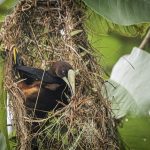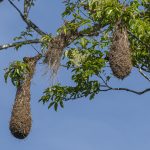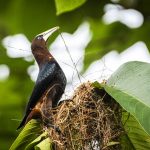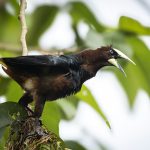1. 🧠 They Are Extremely Social Birds
Chestnut-headed Oropendolas are colonial nesters, meaning they live and breed in large groups. A single colony may contain dozens to over a hundred nests, all hanging from the same tree. This gives the tree a dramatic and beautiful appearance, like a living chandelier.
2. 🌰 Their Name Comes from Their Colors
The bird is named for its chestnut-colored head and neck, which contrast vividly with its black body and bright yellow tail feathers. Males are larger than females and have a more striking display, especially during mating season.
3. 🔊 They Communicate with a Robotic “Pop” and “Whirr”
Their calls are some of the most bizarre in the avian world—sounding like digital pops, creaks, and clicks. Males especially use their strange calls during courtship displays, where they also bow and spread their wings to impress females.
4. 🧵 They Weave Long, Hanging Nests
One of their most astonishing traits is how they build nests. These birds weave pendulous, bag-like nests that can be up to 2 meters (over 6 feet) long!
🪡 How Chestnut-headed Oropendolas Build Their Nest
✅ Materials Used
-
Strips of vines, grasses, palm fibers, and rootlets
-
Sometimes they use twigs and even pieces of cloth or plastic in disturbed areas
-
The fibers are collected and knotted or woven using their beak
🏗️ Construction Process
-
Site Selection: Females usually choose the site, typically on tall isolated trees, often over water or open areas to deter predators.
-
Initial Frame: The female starts by anchoring fibers to a branch. This forms the upper loop of the nest.
-
Weaving: Using a combination of weaving and knotting with her strong, dexterous beak, she builds the long pouch, layer by layer.
-
Shaping the Chamber: The lower part becomes a brooding chamber, well-padded and secure.
-
Time Investment: It can take a few days to over a week to complete a nest.
🧠 Fun fact: Only females build the nests, but males fiercely guard the colony during breeding season.
🦅 Why Hanging Nests?
These incredible nests dangle to:
-
Deter predators like snakes and monkeys
-
Protect eggs from flooding in tropical downpours
-
Allow good ventilation in the humid rainforest climate
🐦 They Practice “Polygynous” Mating
One dominant male may mate with multiple females in a colony. He earns this role by performing elaborate displays and defending his status through vocalizations and body posture rather than fighting.
🐍 Defense Against Parasites
Chestnut-headed Oropendolas have a curious relationship with parasitic cowbirds and botflies, which lay eggs in their nests. In some areas, the oropendolas are thought to form mutualistic relationships with certain wasps that build nests near their colonies—these wasps attack intruders like cowbirds, offering natural pest control.
🌴 Habitat and Range
-
Native to Central America, from southern Mexico through Panama and into parts of northern South America
-
Found in lowland tropical forests, plantations, and forest edges
🌍 Ecological Importance
Their nest colonies support entire ecosystems—from other birds nesting nearby, to predators and scavengers, to symbiotic insects. They’re a great example of how one species can shape an entire microhabitat.






No responses yet